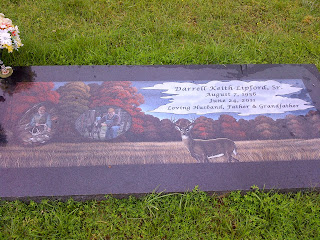Originally, a tombstone was the stone lid of a stone coffin, or the coffin itself, and a gravestone was the stone slab that was laid over a grave. Now all three terms are used for markers placed at the head of the grave. Some graves also contain footstones to mark the end of the grave. Sometimes full sections of granite coping are coordinated with the marker to outline the entire perimeter of the grave or family plot. If footstones are used, they are rarely inscribed with more than the deceased's initials and year of death, or sometimes they reference the cemetery plot number. In some UK cemeteries, the only grave marker is placed at the foot of the grave.
A cemetery may follow national codes of practice or independently prescribe the size and use of certain materials, especially in a conservation area. Others may require stones of a certain shape or position to facilitate grass-cutting by mower. Granite, marble and other kinds of stone are usually created, installed, and repaired by monumental masons. Cemeteries suggest regular inspections and maintenance, as stones may settle and become uneven or may simply become overgrown and lost or vandalized.
The information on the marker generally includes the name of the deceased and their date of birth and death. Such information can be useful to genealogists and local historians and future generations of family. Larger cemeteries may require a discreet reference code as well to help accurately fix the location for maintenance.
Many different designs and granite colors are available for grass markers. Vases, ceramic portraits, bronze embellishments, laser etching and colored litho can be used depending on the final design. They are available in various thicknesses and with multiple finishing options. Families can also purchase special cremation containers and bury the cremains under the marker itself-making these a great choice for burial or cremation.




No comments:
Post a Comment